Pre Modern (1976-79) Freestyle Disc Top Players
(The Decades Awards)
The Decade Awards 1980 Post Modern – Introduction
I have split the 70’s decade into two distinct divisions. The advent of modern freestyle techniques radically redefined the sport. The innovation and perfection of the nail delay and air brushing was the start of the Post Modern era. A more accurate description of the 70’s would be Pioneer (1970-75) , Modern (1976-78) and Post Modern (1980). Another note of relevance; Many players career’s peaked during an overlap in decades. For instance: Jane Englehardt and Suzanne Strait were the most dominant team in women’s freestyle from 1978-1982. I have tried to mention players in this case towards the part of the decade where they had their biggest impact. I have also given credit to performances during major or significant tournaments. As mentioned, this list is brief compared to the depth of the field and scope of play.
The 70’s were a time of innocence. Initially people were doing tricks in an isolated manner. The advent of tournament play acted as a great melting pot of ideas. As people from different areas got together they had a synergistic approach on the game. The end result was light years away from the simple game of throw and catch. As I noted above, the decade is split into two distinct categories. Certainly, the innovation and perfection of modern freestyle techniques (nail delay, airbrushing, tipping and restricted catches) radically changed the sport. With this new found approach, the number or participants exploded. It was during the later part of the decade that the sport experienced its most profound period of growth. Indeed for sheer numbers of players, the sport has never approached this level. At the very onset, the techniques could be mastered during a short period of time. As the game became more elaborate and the learning curves of the modern player more full, it was to become extremely complicated and specialized. That in itself was reason enough for the numbers to dwindle. It is certainly true that this was a time of innocence and also a time of fruition and discovery.
Top Men's Player of the Decade: Late 1970's Modern Era
Erwin Velasquez
What is there to say that hasn't already been said about Erwin. He is truly one of the greatest players and performers of all time. His legacy lives on, fueled by his return to fame winning the US Open in 1994 Ft. Collins with Ted Oberhaus and Bob Coleman and also the 1995 FPA Co-op title with the same team. His high flying style and precise method of play made him the original freestyle god.
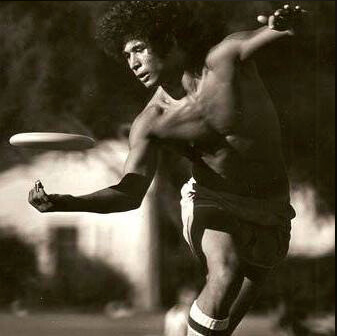
Top Women's Player of the Decade: Late 1970's Modern Era
Laura Engel
Laura got hot and didn't cool off for a very long time. Her long tipping combinations and restricted catches set her apart from the rest of the field. Had an impressive run of victories in the Rose Bowl and FPA's. Had a return to form of sorts when she returned to win the 1986 World Disc title with g rose.
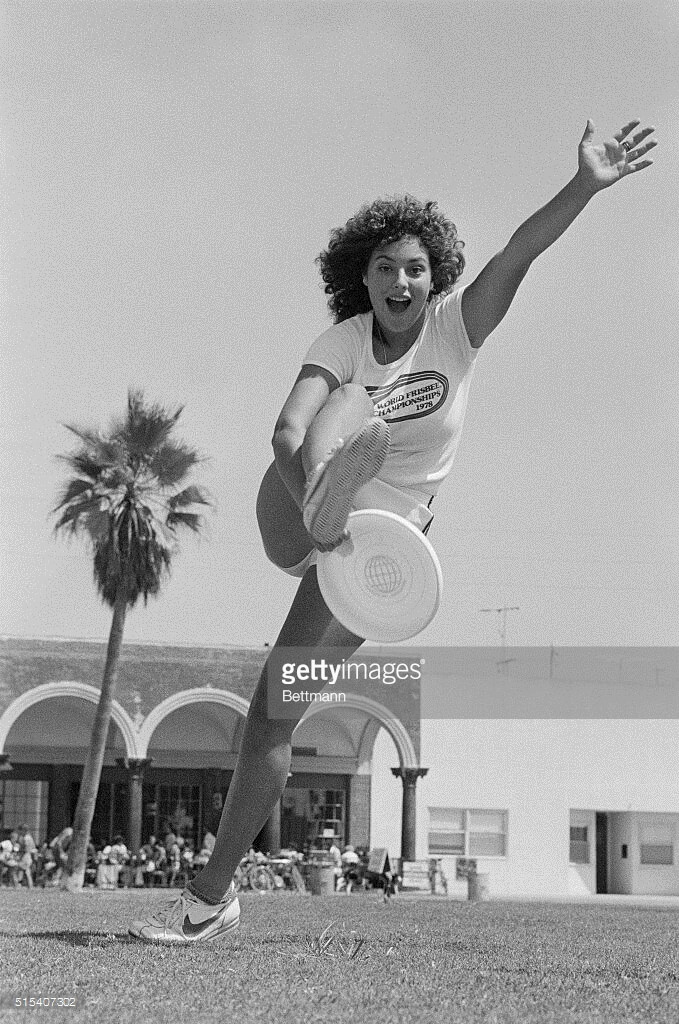
Top Open Team:
Late 1970's Modern Era
Jens Velasquez/Erwin Velasquez
The "V Bros" took the momentum of their 1976 Rose Bowl win and followed it up with another Rose Bowl victory in 1977. They kept a high standard of play into the 80's. Their acrobatic style, long tipping combinations and quirky moves solidified their spot as the best team of the era. They started the new wave of highly skilled modern freestylers. The ante would be upped later with the 1978 Rose Bowl win by Evan David and Corey Basso. After that, the sport would forever be drastically different. But to be sure, the "V Bros" were the standard others looked to.
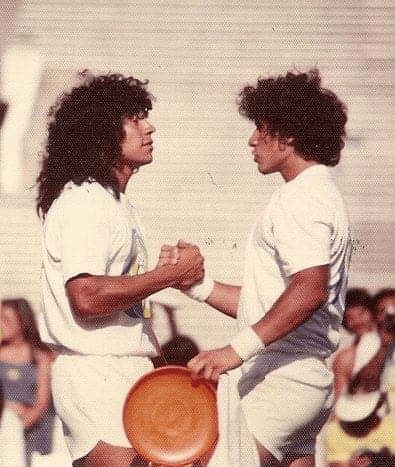
Top Pairs Routine:
Late 1970's Modern Era
Tie:
Erwin Velasquez/Jens Velasquez 1976 Rose Bowl
Dave Marini/John Jewell 1979 Santa Barbara NAS
Erwin and Jens rose above the competition that fateful day. The strongest team in the field was Doug Corea and Dave Marini. After the hottest freestlye ever in history during the semi finals, the bros kept the best for last. No one could stop the “V Bros” express that day. They won the title convincingly and never looked back. Erwin was excellent at acrobatic moves often flying through the air. Jens was the consummate teammate and compliment with laser accurate throws and creative moves. It was captured on film and became part of the legend of disc play.
Dave Marini/John Jewell Santa Barbara Finals 1979 – JJ and Dave did the improbable. The tournament was running way late and darkness fell on Storke Field. There was still one team to go in what had been a great final, the highly touted team of John Jewell and Dave Marini. People pulled their cars up to add any light they could. Even that was minimal and had a negligible effect. They played out of this world and seemed to be on sonar as they pulled off every move in their repertoire to seal the victory. Those who were there were in stunned disbelief. Interestingly enough JJ would follow those theatrics with another hot under the lights routine with Rick Castiglia in the 1980 Indian Summer tourney.
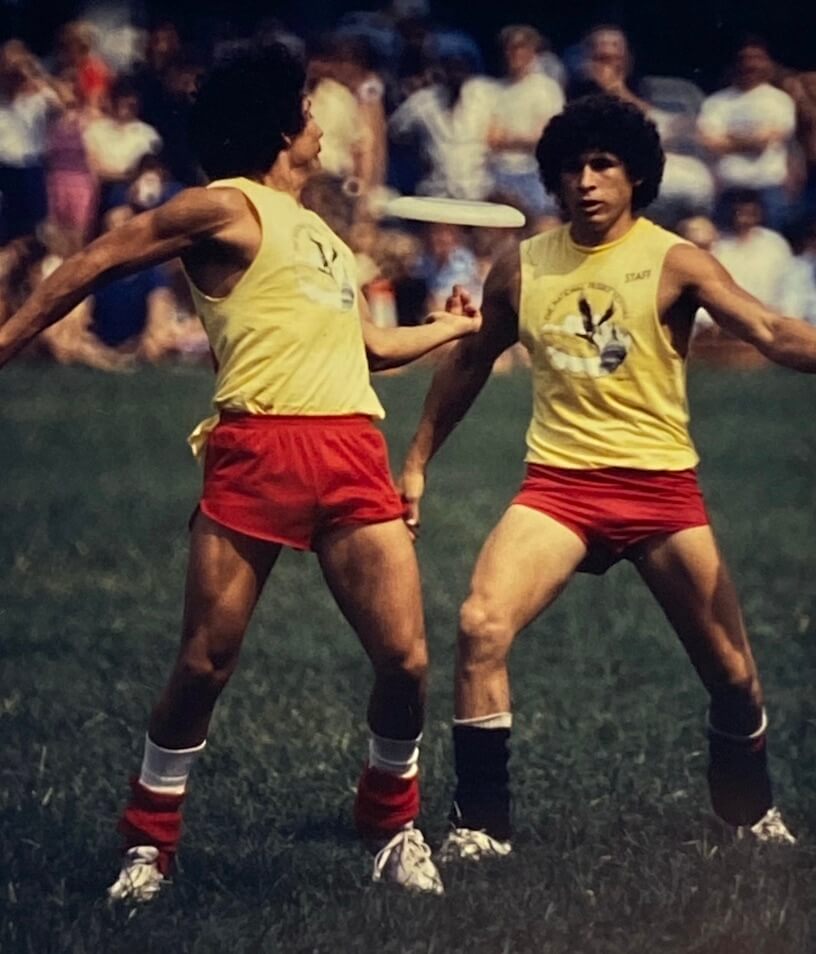
Top Women's Team:
Late 1970's Modern Era
Jane Engelhardt/Suzanne Strait
They were the first “rad chicks”. Jane was the technical wiz and Sue was the graceful complement. They were the first women to do hard sustained combinations. Were also the first women to use a “consecutive” style which was part of their home club Washington Square Wizards game. Jane was intense and driven to perfection. Sue was more laid back but her skills and physical abilities were out of this world. The late 70’s saw a flourish of competitive women but these two were without a doubt the very best of the crop.
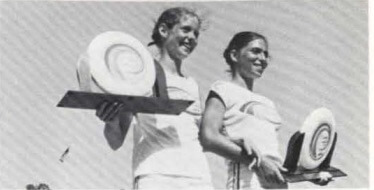
Top Mixed Team:
Late 1970's Modern Era
g rose/Corey Basso
The original mixed team. They won the inaugural mixed division at 1979 Indian Summer and the subsequent FPA World Title in 1980. Both were at the cutting edge of skills and techniques at the time and formed a strong team. Used a heavy dose of dance influence into their routines and looked fantastic.
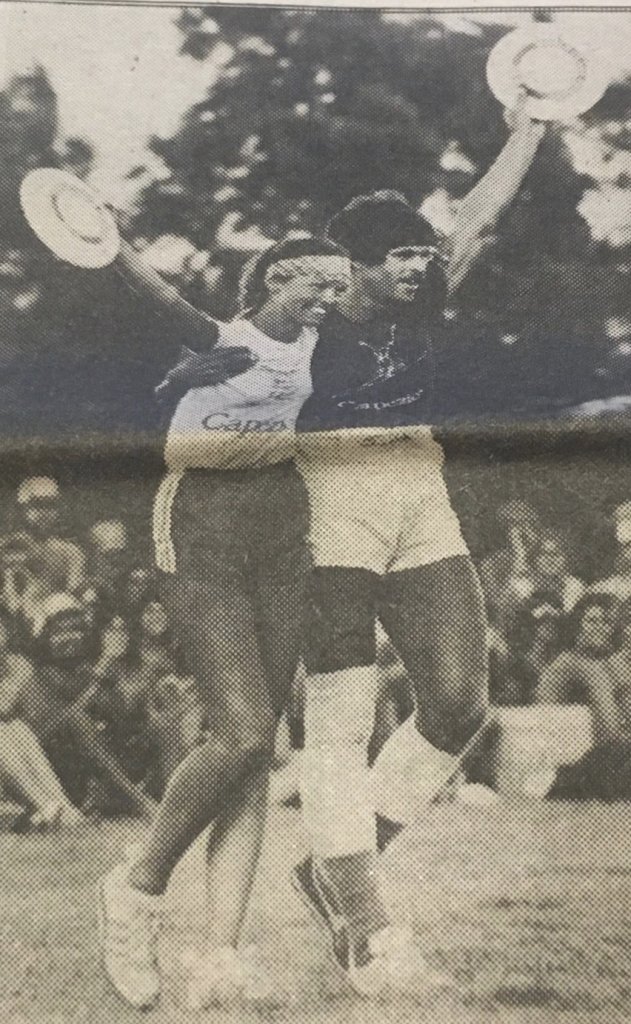
Most Influential:
Late 1970's Modern Era
Joey Hudoklin
Joey was in the upper echelon of players in the late 70’s. He was playing and competing as early as 1976. What set him apart from the rest was traveling to the west coast and showcasing long delay combinations and exquisite control. This would have a profound impact on people’s perception of the game.
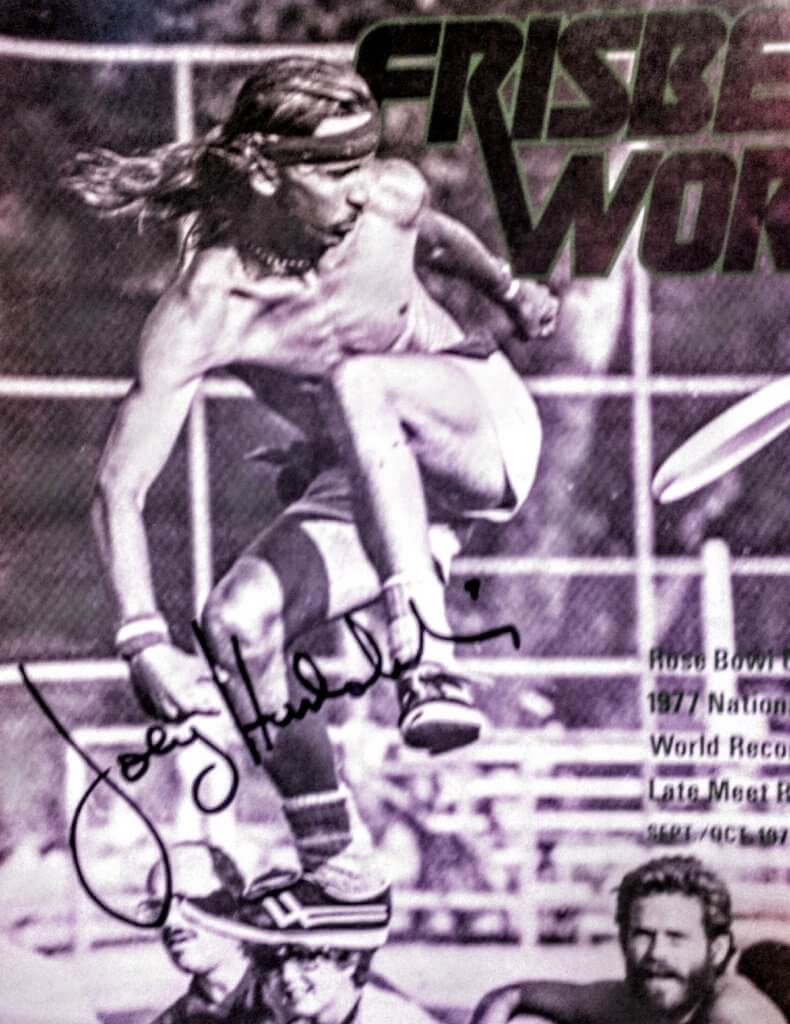
Most Innovative Team: Late 1970's Modern Era
Washington Square Wizards
Joey and Richie were truly the very first modern freestylers. They were not alone in their quest as the myriad of talent from the Wizards and Central Park players pushed them and the sport to new heights. Some of the other notable names from that era were Jeff Felberbaum and John Dwork just to name a few. But it was Joey and Richie who were winning acclaim as they began to win tournament after tournament. Credit is also due to the Central Park freestlyers such as Kerry Kolmar, Krae Van Sickle, Freddie Haft, Clarence Braithwaite, Rob Fried and Roger Meier.

Most Innovative:
Late 1970's Modern Era
Krae Van Sickle
A master showman and player wrapped up into one. An original Style master. His most prolific competition days are behind him. He has recently been “rediscovered” as the feature of the “Zen and the Art of Freestyle” video by Pat Rabdau. He created a wide variety of catches such as the Flamingitis and Scarecrow. Had mastered all the skills of play before he was 20 years old. His father Ken was a disc enthusiast and inspired his son to play. He is the original “Frisbee Baby”. The consummate freestyler.

Best Beach/Wind Player:
Late 1970's Modern Era
Tom "T Shep" Shepard
“T Shep” honed his skills on the beaches of Santa Barbara where he teamed with Tom Kennedy. His long blond tresses and feathery touch made him the envy of many a young player who were quick to emulate the master. Probably the first person (along with partner Tom Kennedy) to realize the potential for the wind game. He was doing cuffs, glides, rides and other assorted modern wind techniques. One thing he and TK did that blew minds was at the end of their Rose Bowl Semifinal routine in 1976, they air brushed off the field of play together and kept going and going…

Most Athletic Man:
Late 1970's Modern Era
Tom "TK" Kennedy
Although not a pure freestlyer, Tom Kennedy gets the nod for his overall abilities which also transferred over to freestyle. “TK” was one of the original Disc Golf champions, a Self Caught Flight champion and most notably, the Team Captain and kingpin of the juggernaut Santa Barbara Condors Ultimate team. There is little doubt that if his passion was for freestyle, he would have been a World Champion. Had a great touch with the disc. Adept at the wind game before it was common place. Great competitor in all regards.
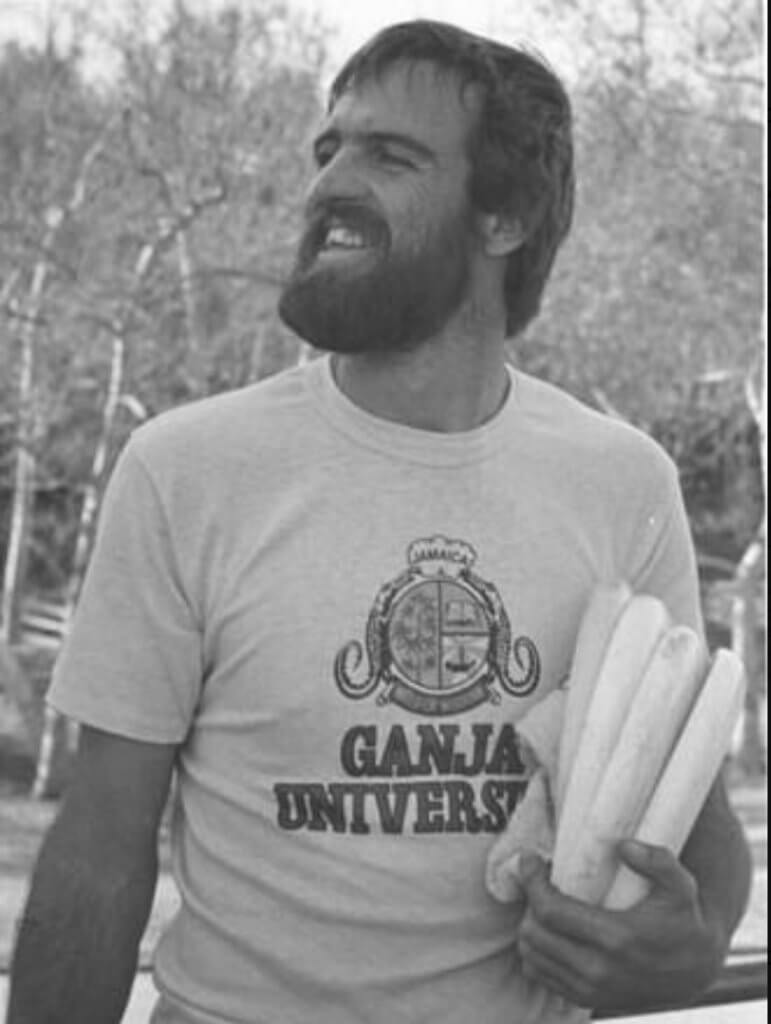
Most Athletic Woman:
Late 1970's Modern Era
Michele Pezzoli
Michelle was one of the original United Flyers of Sonoma (UFOS). Moved to Santa Barbara and teamed with Cyndy Birch. She was a very smooth freestyler and did her best under pressure. Was also skilled in all aspects of disc play. Was the original team captain for the World Champion Santa Barbara Lady Condors.

Best Form Men:
Late 1970's Modern Era
Evan David
Evan was simply beautiful to watch. He was a natural athlete and had a flair for style. He studied dance at Sonoma State and used it in unique and accessible ways. Originally from Santa Barbara and later a United Flyer of Sonoma. He and Corey Basso reset the standard of hot play. If he would have continued to play he would have been considered one of the best players ever.
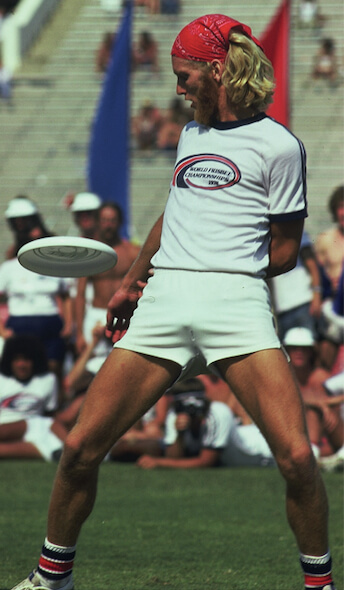
Best Form Woman:
Late 1970's Modern Era
Suzanne Strait
A formally trained ballerina, her form was exquisite. She had flexibility that was off the scale. Her Bad Attitude catch was over her head for crying out loud. Made a strong team with the athletic Jane Englehart.
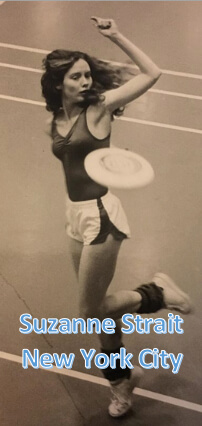
Most Underrated:
Late 1970's Modern Era
Matt and Brian Roberts
I don’t know if they were so truly underrated but they played at an incredibly high level for a long time. Their normal third was John Jewell and they complemented his play perfectly. They were known for their strong play all up and down the west coast. Brian’s tipping combos and Matt’s aerial catches.
Top International Player:
1970's Modern Era
John Anthony (CAN)
JA teamed with the Kitsalono Koastal Kats (Jim Brown and Bill King). They were originally a bunch of eccentric jugglers who very quickly saw the potential for disc play. This team was also one of the most innovative and influential teams of all time. Credit goes to them for creating what was termed “micronesia”, where players would stand in close proximity to one another and be able to perform high z throws and passes. John was the best player of the group however Jim and Bill were no slouches. JA honed his game while going to Columbia University, playing with the Central Park gang and the Washington Square Wizards. The Vancouver guys created the game called Kosmic Katastophies, a game of double paddidles. Jim was undefeated during his career. His ability to control both paddidles is still unprecedented. Bill was host of the traveling revue known as the “Bill King Show”, putting on satirical theatrics during parties at tournaments. One of these shows introduced a young Modest Mutant with the moniker “Skippy Jammer”.
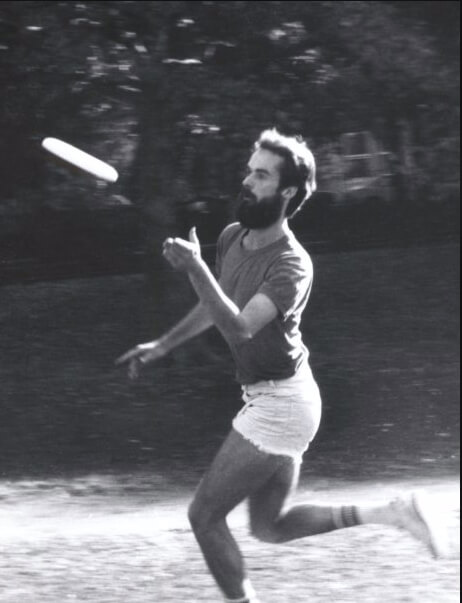
More information on freestyle frisbee
Follow freestyle frisbee